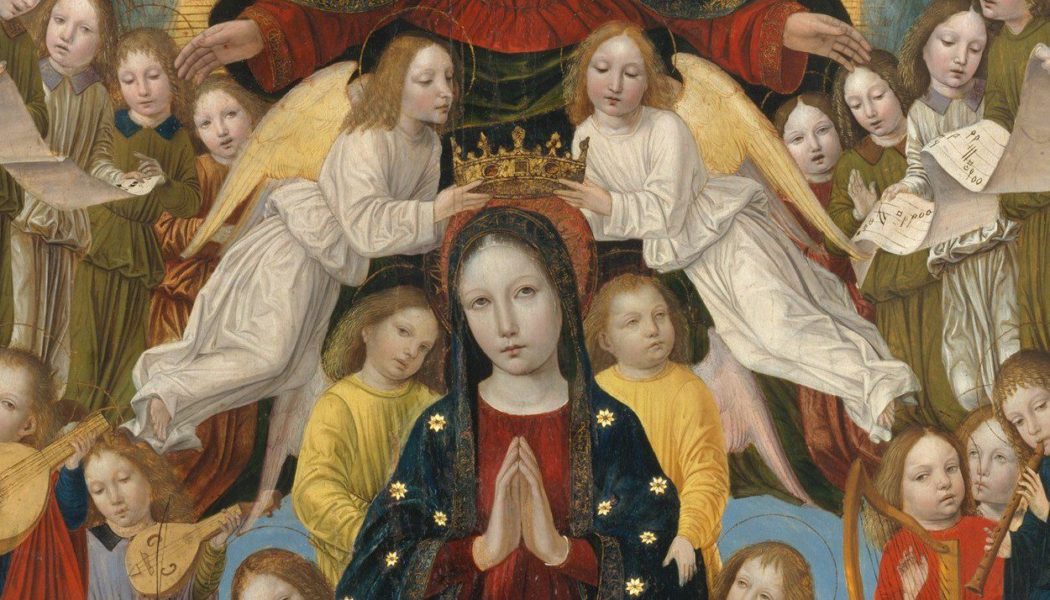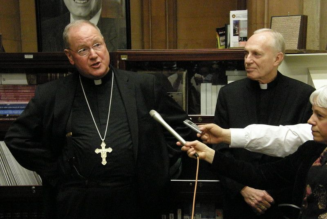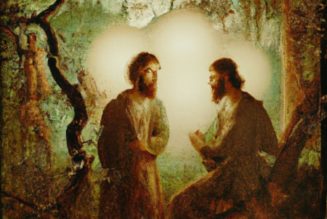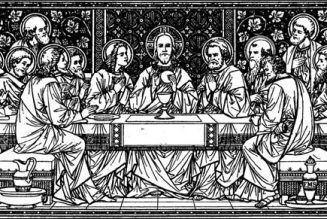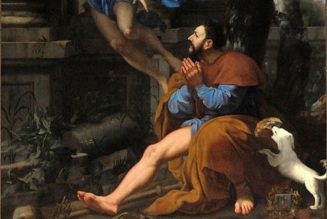
A great sign appeared in heaven: a woman clothed with the sun, and the moon beneath her feet, and on her head a crown of twelve stars. –Entrance antiphon, Mass for the Feast of the Assumption during the Day
Like Jesus, Mary’s Son—who is the Word in the beginning, the Second Adam at the center of salvation history, and the Bridegroom whose wedding banquet at the end lasts forever—Mary appears to us at the beginning, middle, and end of Sacred Scripture. A type of “second Eve” announced after the Fall, she gives birth to the Savior in time, and at the end of her life is assumed by God to her glorious reward in heaven. Today’s Solemnity of the Assumption celebrates her heavenly destiny—and invites us to renew our own desire to achieve this same goal.
Our story begins in the dust of the earth: “The Lord God formed man of dust from the ground, and breathed into his nostrils the breath of life; and man became a living soul” (Genesis 2:7). At the beginning of each Lenten season, as dust is applied to our foreheads on Ash Wednesday, we hear, “Remember that you are dust, and to dust you shall return” (see Genesis 3:19). But Mary’s assumption does not leave us in the dust! Rather, she gives us a hope for greater things. As Pope Pius XII addressed Mary in his declaration of the dogma of the Assumption, “It is written, that you appear in beauty, and your virginal body is altogether holy, altogether chaste, altogether the dwelling-place of God; from which it follows that it is not in its nature to decay into dust, but that it is transformed, being human, into a glorious and incorruptible life, the same body, living and glorious, unharmed, sharing in perfect life.”
Still, the heights Mary assumed remain rooted in the earth, even if she never returns to it. Mary embodies one of the many paradoxes of our faith—namely, that greatness is achieved only through humility. Jesus is the supreme example of such exaltation-via-lowliness. As Paul’s letter to the Philippians tells us, “Though he was in the form of God, [he] did not count equality with God a thing to be grasped, but emptied himself, taking the form of a servant, being born in the likeness of men. And being found in human form he humbled himself and became obedient unto death, even death on a cross. Therefore, God has highly exalted him and bestowed on him the name which is above every name” (Philippians 2:6–9). You may recall that the words “humility” and “human” share a common root—humus, or earth, dirt. Only by realizing who we are and what God made us to be on earth will we reach our supernatural life in heaven.
Mary’s humility, like her Son’s, launches her into the heavens at her Assumption. The readings and prayers of the day’s liturgies make this point clear. The Church’s Opening Prayer for the Vigil Mass combines both humility and glory in the praise of the Mother of God: “O God, who, looking on the lowliness of the Blessed Virgin Mary, raised her to this grace.” But the pinnacle of Mary’s lowliness resounds in the Magnificat (“My soul magnifies”) upon her visit to Elizabeth, read at the gospel for the Mass during the day.
Before looking briefly at this text (which has been prayed at Evening Prayer around the world for centuries), we should note that another of her lowly attributes also leads to her greatness and ultimate Assumption: her obedience. To obey means “to hear,” and in Mary’s case, this meant to hear the message of God. Today, as in all times throughout history, obedience is not deemed so much a virtue as it is a vice for the weak-willed and slavish. But Mary’s greatness grows out of her obedience. Obey the Word, conceive the Word. “You are blessed,” says St. Ambrose on the doorstep of Christmas, “because you have heard and believed. A soul that believes both conceives and brings forth the Word of God and acknowledges his works.” Rather than listening to herself and her own will, Mary obediently believes an authority greater than herself. And for this credulity, her reward is magnificent.
It was obedience, too, which led Mary to visit her cousin Elizabeth. When Mary learned of her cousin’s miraculous pregnancy, she immediately left to visit her. After Elizabeth greets her with the words, “Blessed is she who believed that there would be a fulfillment of what was spoken to her from the Lord” (Luke 1:45), Mary begins her magnificent hymn of praise to the Father: “My soul magnifies the Lord, and my spirit rejoices in God my Savior, for he has regarded the low estate of his handmaiden. For behold, henceforth all generations will call me blessed…. [H]e has put down the mighty from their thrones, and exalted those of low degree” (Luke 1:46–48, 52). Is it because Mary considered herself the lowliest of God’s subjects that he would eventually raise her to the very greatness of the Lord?
Pope Pius XII thought so. In 1950, after consultation with all of the bishops of the world, he declared the Assumption of the lowly Blessed Virgin Mary into heaven a dogma of the Church: “By the authority of our Lord Jesus Christ, of the Blessed Apostles Peter and Paul, and by our own authority, we pronounce, declare, and define it to be a divinely revealed dogma: that the Immaculate Mother of God, the ever Virgin Mary, having completed the course of her earthly life, was assumed body and soul into heavenly glory.” Along with Mary’s assumption, the Church’s liturgy exhorts us to imitate her glory: “Today the Virgin Mother of God was assumed into heaven as the beginning and image of your Church’s coming to perfection and a sign of sure hope and comfort to your pilgrim people.” Thus, may we—like Christ, like Mary—by our lowliness be brought, body and soul, to the glories of heaven.
The above entry appears in Ascension’s book Solemnities: Celebrating a Tapestry of Divine Beauty, by Christopher Carstens, Denis McNamara, and Alexis Kutarna. Featuring each of the 17 annual solemnities, Solemnities: Celebrating a Tapestry of Divine Beauty examines the theological, spiritual, and liturgical foundations for each celebration; explains the beauty of the solemnity by a commentary on artistic illustration of the celebration; and offers ideas for living the solemnity in one’s daily life. Solemnities: Celebrating a Tapestry of Divine Beauty was awarded Second Place in the “Pastoral Ministry—Parish Life” category by the Catholic Media Association in 2023. See more about the book at https://ascensionpress.com/products/solemnities-celebrating-a-tapestry-of-divine-beauty.
Christopher Carstens is director of the Office for Sacred Worship in the Diocese of La Crosse, Wisconsin; a visiting faculty member at the Liturgical Institute at the University of St. Mary of the Lake in Mundelein, Illinois; editor of the Adoremus Bulletin; and one of the voices on The Liturgy Guys podcast. He is author of A Devotional Journey into the Mass and A Devotional Journey into the Easter Mystery (Sophia), as well as Principles of Sacred Liturgy: Forming a Sacramental Vision (Hillenbrand Books). He lives in Soldiers Grove, Wisconsin, with his wife and children.
Image Source: AB/Wikimedia. The Assumption of the Virgin, by Ambrogio Borgognon.
